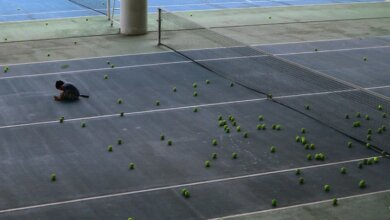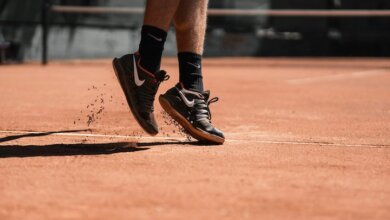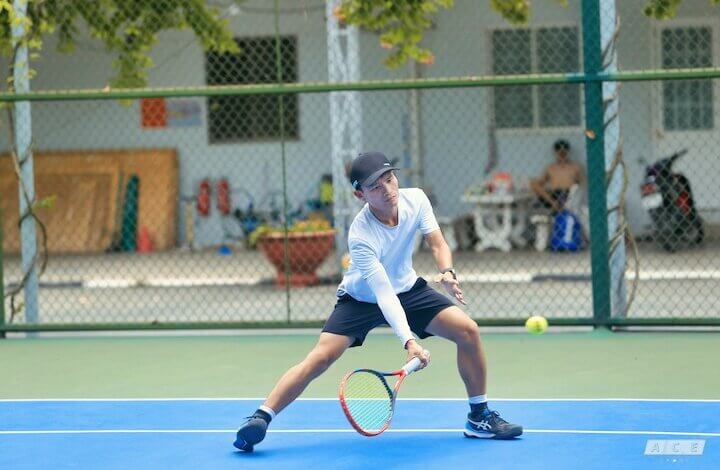
We're an affiliate
We hope you love the products we recommend! Just so you know, we may collect a share of sales or other compensation from the links on this page. Thank you if you use our links, we really appreciate it!
If you’ve ever stood at the net, racket in hand, and wondered how people make volleys look so easy — you’re not alone. I remember the first time I tried to practice how to volley like a pro. The ball shot past me so fast I barely saw it, let alone hit it.
But here’s the thing: volleying isn’t about power. It’s not about doing a hundred things at once either. It’s about timing, positioning, and keeping it simple.
In this post, I’ll walk you through how to volley like a pro without overwhelming you. I’ll break everything down into small, easy-to-follow steps. No fluff. No confusing jargon. Just you and me figuring it out together — one clean volley at a time.
Table of Contents
Key Takeaways
- A volley is a shot you hit before the ball bounces.
- The continental grip gives you control and flexibility.
- Use a split step and small steps to move quickly at the net.
- Don’t swing — guide the ball with short, firm motion.
- Timing matters more than strength.
- Practice with simple drills like wall volleys and partner catches.
- Keep your mindset calm and confident.
- Fix common mistakes like over-swinging and flat feet to improve fast.
What a Volley Really Is (And What It’s Not)
Before you start adjusting your grip or drilling footwork, let’s clear something up. A volley in tennis is when you hit the ball before it bounces. That’s it.
You’re usually standing close to the net, waiting to intercept the ball early. Unlike a groundstroke — which happens after the bounce — a volley is more about control than power.
And no, you don’t need to swing like you’re hitting a home run. That’s the biggest mistake most players make. When you try too hard, your shots fly out or straight into the net.
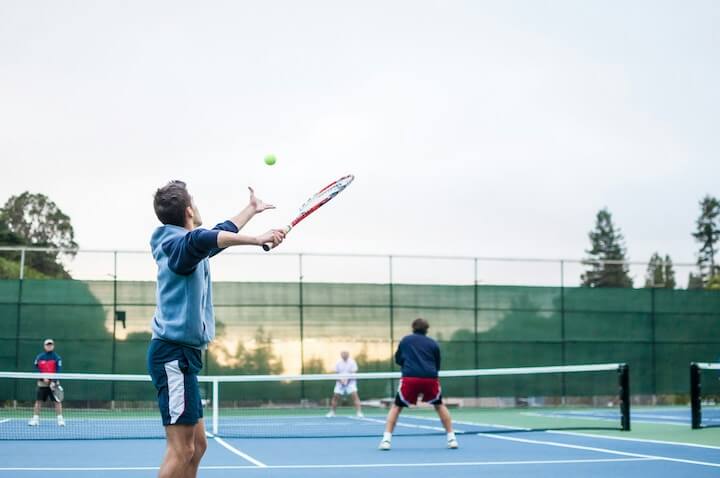
The Right Grip and Ready Position
To volley like a pro, you’ve got to start right — with your grip and how you stand.
You’ll want to use the continental grip. I know, that might sound technical. But think of it like this: imagine shaking hands with the racket. That natural position? That’s it. You’re good to go.
Now your stance. Keep your knees slightly bent. Racket in front of you, both hands holding it, ready for anything. Feet shoulder-width apart. You’re not locked in place — you’re just relaxed and alert.
It should feel like you’re standing on springs. Not stiff, not wobbly — just balanced and ready.
Also Read: 12 Best Durable Tennis Shoes For Both Men and Women
Mastering Footwork at the Net
This is where it gets real. Volleying isn’t just about your hands. It’s your feet that get you into the right spot. If they’re not moving, you’re not volleying well.
You’ve probably heard of the split step — but if you haven’t, no stress. Here’s what it is: just before your opponent hits the ball, you do a small hop and land on the balls of your feet. That hop sets you up to move quickly in any direction.
Then, it’s all about short, quick steps. No big leaps. Just small, smart moves to get your body behind the ball. That’s what gives you control.
When your footwork clicks, everything else follows. You’ll feel smoother, faster, and more in control — all without rushing.
How to Volley Like a Pro: Use Your Hands, Not Your Arms
Let me tell you what I used to do wrong: swing like I was hitting a forehand. Every volley I hit either flew long or slammed into the net. You might’ve done the same.
To volley like a pro, stop swinging.
You’re not trying to crush the ball. You’re trying to block it, or punch it, depending on the pace.
Your wrist stays firm. The motion is short and compact. It’s more like you’re guiding the ball than hitting it.
Think of your racket as a wall. The ball comes in, and you just redirect it. That’s it. Simple, clean, calm.
The Secret? It’s Timing and Simplicity
Here’s something no one told me when I was learning: volleying is more about when than how hard.
If you meet the ball early, clean, and quiet — it doesn’t need to be powerful. It just needs to go where you want it.
You don’t have to muscle it, don’t have to impress anyone. All you need to do is to be there when the ball is there — and then let your racket do the rest.
Trying too hard is the enemy. Trust me, when you relax, your volleys will improve overnight.
How to Volley Like a Pro: 3 Drills That Build Real Skill
Want to actually feel the difference? These three drills will get you there faster than anything else. You don’t need fancy gear. Just a racket, a ball, and maybe a wall or a partner.
Wall Volley Drill
- Stand a few feet from a solid wall.
- Hit gentle volleys without letting the ball bounce.
- Keep the motion short and quiet.
- Focus on control, not speed.
You’ll miss a bunch at first. That’s normal. Stick with it. You’ll start feeling the rhythm soon.
Catch-and-Volley Partner Drill
- Have your partner toss the ball underhand.
- You volley it gently into their hands.
- Switch roles.
This builds touch and accuracy fast. You’ll learn to stop overhitting and start aiming.
No-Racket Shadow Footwork
- Practice split steps and side steps in front of a mirror.
- Watch your posture.
- Stay light on your toes.
- No racket needed — just focus on how your body moves.
This gets your legs ready without distraction.
Pro Volley Mindset (This Changes Everything)
To volley like a pro, you have to think like one.
Pros aren’t nervous at the net. They’re calm. Focused. In control. You can be too.
It’s not about reacting to every ball in panic. It’s about expecting it. Trusting yourself. You don’t need to overthink every move.
Here’s a trick: when you’re at the net, imagine you’re playing catch. Not tennis — just catch. You see the ball, you meet it, you redirect it. That’s the whole game.
This mental shift changed everything for me.
Check Out: 10 Best Tennis Shoes For Clay Court
Mistakes to Avoid (And What to Do Instead)
You’re going to mess up some volleys. We all do. But these mistakes are easy to fix once you spot them:
- Over-swinging
Fix: Shorten your motion. Keep the racket in front of you. - Standing flat-footed
Fix: Do the split step before every volley. - Too much wrist movement
Fix: Keep your wrist still and your grip firm. - Watching the ball too late
Fix: Focus on your opponent’s racket, not just the ball.
Each time you fix one of these, your volleys get better instantly.
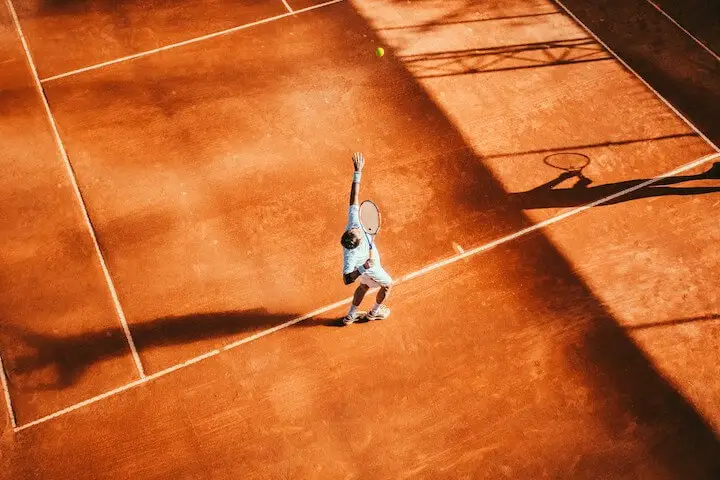
Conclusion
Learning how to volley like a pro isn’t about being perfect. It’s about doing the small things well.
You don’t need fast hands or a killer swing. All you need is balance, timing, and a calm mind.
Start with the grip. Get your stance right. Work on footwork and drills. Fix one mistake at a time. That’s how it happens.
Trust yourself. You’ll see the improvement fast — and when that clean volley lands just over the net, you’ll know it’s working.
Frequently Asked Questions
What grip should I use for volleys?
You should use the continental grip. It feels like a handshake with the racket and gives you better control and quicker reactions at the net.
Why do I miss easy volleys at the net?
Chances are you’re swinging too much or standing flat-footed. Keep your motion short and stay light on your feet using the split step.
How can I get faster reaction time at the net?
Start with a split step every time your opponent hits. That small bounce will prime your body to move faster.
Do I need strength to hit powerful volleys?
Not really. Volleying is more about timing and placement. A calm, well-timed volley does more damage than a hard hit one.
Can beginners learn to volley like a pro?
Absolutely. It just takes a few small changes and the right kind of practice. Start simple. Keep your mind clear. You’ll get there.

